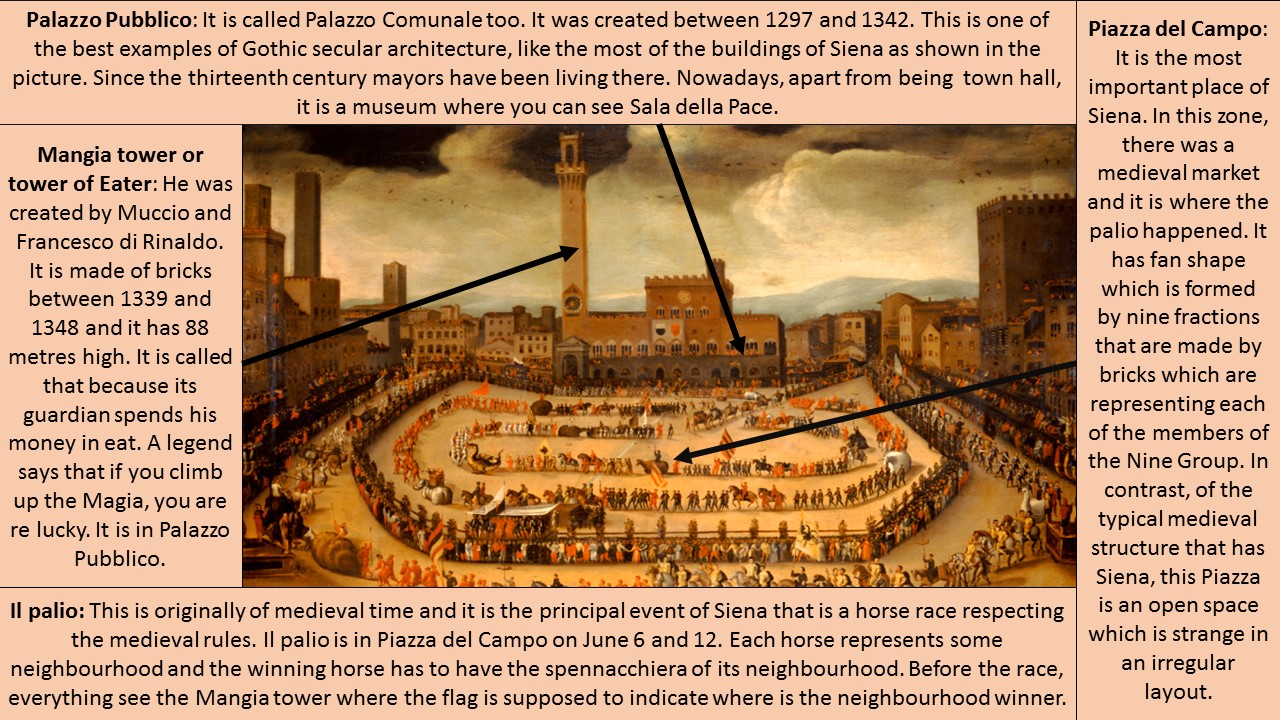
This work of art was painted with oil on canvas by Vincenzo Rustici (1556-1632). The city which appears in this painting is Siena, a city which is situated in the region of Tuscany (Italy). The image represents the moment when the parade of the seventeen neighborhoods is been performed around Piazza del Campo during the festival of Il Palio. It is preserved at the San Donato Museum in Siena.
Siena is situated in the region of Tuscany. It is located among three hills in the North Arsia valley, home of the wine Brunello di Montalcino. In the north of Siena, they can find Elsa where there are olives and vineyards, which are for the famous wine “Chianti”. There is not any river in the surface of the city, but there is a legend telling about an underground river whose name is Diana. Because of being surrounded by olives and vineyards, the main economic activities are related to agriculture and commerce. Apart from this, Il Palio attracts many people for tourism.
Siena has been adapted to a difficult topography that has impeded urban growth and has kept the city within a medieval atmosphere. Thus, the streets are narrow and there is a city wall that surrounds a big part of the town. Originally, Siena was divided in three quarters, but nowadays the city is divided in seventeen districts. The city wall protects the historical quarter and its function is defensive apart from spreading the water to water fountains. This wall has six gates and the most important is Camollia Gate which gives name to one of the neighborhoods, formed by six districts. Di San Martino is another area in the middle east of Siena and includes five districts: Civetta, Leocomo, Nicchio, Montone and Torre. This quarter receives this name from San Martino church, a very important pigrimage destination in the Middle Ages. There it is the historic center of the city and the Town Hall, in the Piazza del Campo. There are several streets departing from the piazza in a radial way. One of them leads to the Duomo or Cathedral, made in the 14th century,that is one of the most importat monuments in Siena. It is in the Piazza del Campo where the festival of Il Palio is celebrated twice a year, as it is shown in the picture.
The political importance of Siena has diminished over the years. During centuries, Siena was the most important city of Tuscany but as the years passed, the internal struggles between aristocrats and common people made that Siena lost its political importance in favor of Florence. This struggles were produced because aristocrats wanted more territory and kicked out common people. Apart from this, the differences between rich people and common people grew steadily and this produced more struggles. An anecdote of this struggles is that when people was going to fight, they prayed to virgin Mary; that shows the importance of religion in the Middle Ages.
In the picture, we can appreciate a few urban elements that are the most important of Siena, such as the Mangia tower, which is the bell tower of the Palazzo Pubblico, and the Palazzo Pubblico itself, which is an exemplary of Gothic secular architecture. This bulding was the Town Hall since the 13th century, when the nine-government ruled in Siena, but nowadays it is a museum too. The Duomo is one of the most important cathedrals in Italy and has artistic treasures of Bernini, Donatello and Miguel Angel. Santa María della Scala is important too because it was one of the oldest hospitals in Europe and nowadays there are a lot of museums inside it. In conclusion, Siena has not changed very much and is really similar today as it was in the Middle Ages. Its historical center with the Piazza del Campo deserved the consideration as a World Heritage site by UNESCO.
Pablo José Sánchez del Saz
